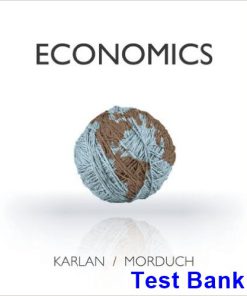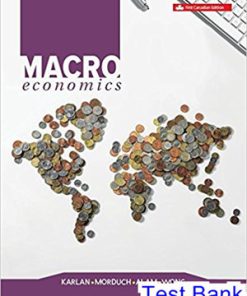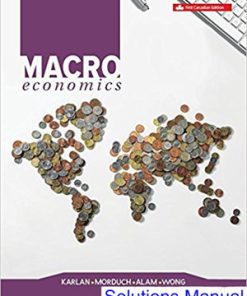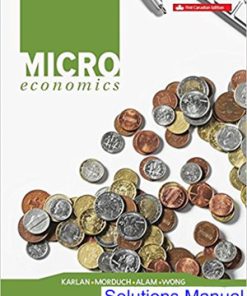This is completed downloadable of Microeconomics Canadian 1st Edition Karlan Test Bank
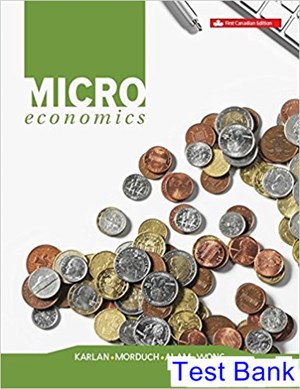
Product Details:
- ISBN-10 : 0070265143
- ISBN-13 : 978-0070265141
- Author: Dean Karlan (Author), Jonathan Morduch (Author), Rafat Alam (Author), Andrew Wong (Author)
Karlan/Morduch Microeconomics, Canadian Edition, shows students the power of economics in understanding, analyzing, and solving problems, whether they are huge global problems or problems in their everyday life. Taking a global perspective with Canada as a leading example, the distinguished author team of Dean Karlan and Jonathan Morduch, along with Canadian authors Rafat Alam and Andrew Wong, presents real-life examples and issues that resonate with the student experience, in order to reinforce economic principles. This text is ideal for professors who want to keep their students engaged and who are seeking to deliver core economic principles through a lens of real-life examples, in order to help students become sound economic decision makers.
Table of Content:
- PART 1 The Power of Economics
- Chapter 1 Macroeconomics and Life
- Making an Impact with Small Loans
- The Basic Insights of Macroeconomics
- Scarcity
- Performance and Decision Making
- Incentives
- Efficiency
- An Economist’s Problem-Solving Toolbox
- Correlation and Causation
- Models
- Positive and Normative Analysis
- Conclusion
- Chapter 2 Specialization and Exchange
- The Origins of a T-Shirt
- Production Possibilities
- Drawing the Production Possibilities Frontier
- Choosing Among Production Possibilities
- Shifting the Production Possibilities Frontier
- Absolute and Comparative Advantage
- Absolute Advantage
- Comparative Advantage
- Why Trade?
- Specialization
- Gains from Trade
- Comparative Advantage Over Time
- Conclusion
- APPENDIX A Math Essentials: Understanding Graphs and Slope
- Creating a Graph
- Graphs of One Variable
- Graphs of Two Variables
- Slope
- Calculating Slope
- The Direction of a Slope
- The Steepness of a Slope
- PART 2 Supply and Demand
- Chapter 3 Markets
- Mobiles Go Global
- Markets
- What Is a Market?
- What Is a Competitive Market?
- Demand
- The Demand Curve
- Determinants of Demand
- Shifts in the Demand Curve
- Supply
- The Supply Curve
- Determinants of Supply
- Shifts in the Supply Curve
- Market Equilibrium
- Reaching Equilibrium
- Changes in Equilibrium
- Conclusion
- APPENDIX B Math Essentials: Working with Linear Equations
- Interpreting the Equation of a Line
- Turning a Graph into an Equation
- Turning an Equation into a Graph
- Equations with x and y Reversed
- Shifts and Pivots
- Solving for Equilibrium
- Chapter 4 Elasticity
- Canada’s Everyday Drink
- What Is Elasticity?
- Price Elasticity of Demand
- Calculating Price Elasticity of Demand
- Using the Mid-point Method
- Determinants of Price Elasticity of Demand
- Using Price Elasticity of Demand
- Price Elasticity of Supply
- Calculating Price Elasticity of Supply
- Determinants of Price Elasticity of Supply
- Other Elasticities
- Cross-Price Elasticity of Demand
- Income Elasticity of Demand
- Conclusion
- APPENDIX C Math Essentials: Calculating Percentage Change, Slope, and Elasticity
- Percentage Change
- Slope and Elasticity
- Q over P, or P over Q?
- Elasticity Changes Along Lines with Constant Slope
- Chapter 5 Efficiency
- A Broken Laser Pointer Starts an Internet Revolution
- Willingness to Pay and Sell
- Willingness to Pay and the Demand Curve
- Willingness to Sell and the Supply Curve
- Measuring Surplus
- Consumer Surplus
- Producer Surplus
- Total Surplus
- Using Surplus to Compare Alternatives
- Market Equilibrium and Efficiency
- Changing the Distribution of Total Surplus
- Deadweight Loss
- Missing Markets
- Conclusion
- APPENDIX D Math Essentials: The Area Under a Linear Curve
- The Area Under a Linear Curve
- Chapter 6 Government Intervention
- Feeding the World, One Price Control at a Time
- Why Intervene?
- Three Reasons to Intervene
- Four Real-World Interventions
- Price Controls
- Price Ceilings
- Price Floors
- Taxes and Subsidies
- Taxes
- Subsidies
- Evaluating Government Interventions
- How Big is the Effect of a Tax or Subsidy?
- Long-Run versus Short-Run Impact
- Conclusion
- PART 3 The Data of Macroeconomics
- Chapter 7 Measuring GDP
- It’s More than Counting Berries
- Valuing an Economy
- Unpacking the Definition of GDP
- Production Equals Expenditure Equals Income
- Approaches to Measuring GDP
- The Expenditure Approach
- The Income Approach
- The Value-Added Approach
- Using GDP to Compare Economies
- Real versus Nominal GDP
- The GDP Deflator
- Using GDP to Assess Economic Health
- Limitations of GDP Measures
- Data Challenges
- GDP versus Well-Being
- Conclusion
- Chapter 8 The Cost of Living
- Get Cracking
- The Cost of Living
- Measuring Price Changes Over Time
- The Market Basket
- Consumer Price Index
- The Challenges in Measuring Price Changes
- Using Price Indexes
- The Inflation Rate
- Deflating Nominal Variables
- Adjusting for Inflation: Indexing
- Accounting for Price Differences Across Places
- Purchasing Power Parity
- Purchasing Power Indexes
- PPP-Adjustment
- Conclusion
- PART 4 Labour Market and Economic Growth
- Chapter 9 Unemployment and the Labour Market
- What Does It Mean to Be Unemployed?
- Defining and Measuring Unemployment
- Where Does the Data Come From?
- Measuring Unemployment
- Beyond the Unemployment Rate
- Equilibrium in the Labour Market
- Categories of Unemployment
- Natural Rate of Unemployment
- Cyclical Unemployment
- Public Policies and Other Influences on Unemployment
- Factors That May Stop Wage Rates from Falling
- Employment Insurance
- Other Factors: Taxes and Worker Rights
- Conclusion
- Chapter 10 Economic Growth
- Why Economic Growth Matters
- Economic Growth Through the Ages
- History of World Growth
- Compounding and the Rule of 70
- Determinants of Productivity
- Productivity Drives Growth
- Components of Productivity
- Rates versus Levels
- Accounting for Growth
- Convergence
- Growth and Public Policy
- Investment and Savings
- Education and Health
- Technological Development
- Laying the Groundwork: Good Government, Property Rights, and Economic Openness
- The Juggling Act
- Conclusion
- PART 5 The Economy in the Short and Long Run
- Chapter 11 Aggregate Expenditure
- The Big Crash
- The Components of Aggregate Expenditure
- Consumption
- Investment
- Government Spending
- Net Exports
- Autonomous Expenditure and Simplifying Assumptions
- Aggregate Expenditure Equilibrium and the Keynesian Cross
- Actual versus Planned Aggregate Expenditure
- Keynesian Equilibrium
- Output Gaps
- The Multiplier Effect
- Conclusion
- APPENDIX E Math Essentials: Algebra and Aggregate Expenditure
- Using Algebra to Find Equilibrium Aggregate Expenditure
- Using Algebra to Derive the Expenditure Multiplier
- Chapter 12 Aggregate Demand and Aggregate Supply
- Pop! Goes the Bubble
- Tying It All Together
- Aggregate Demand
- The Aggregate Demand Curve
- Shifting the Aggregate Demand Curve
- The Multiplier and Shifts in Aggregate Demand
- Aggregate Supply
- The Difference Between Short-Run and Long-Run Aggregate Supply
- Shifts in the Short-Run Aggregate Supply Curve
- Shifts in the Long-Run Aggregate Supply Curve
- Do the LRAS and SRAS Always Shift Together?
- Economic Fluctuations
- Effects of a Shift in Aggregate Demand
- Effects of a Shift in Aggregate Supply
- Comparing Demand and Supply Shocks
- The Role of Public Policy
- Government Spending to Counter Negative Demand Shocks
- Government Spending to Counter Negative Supply Shocks
- Conclusion
- Chapter 13 Fiscal Policy
- From Prosperity to Great Recession
- Fiscal Policy
- Expansionary or Contractionary?
- Policy Response to Economic Fluctuations
- Real-World Challenges
- Policy Tools—Discretionary and Automatic
- Limits of Fiscal Policy: The Money Must Come from Somewhere
- The Government Budget
- Revenue and Spending
- The Budget Deficit
- The Public Debt
- Size of the Debt
- How Does the Government Go Into Debt?
- Is Government Debt Good or Bad?
- Conclusion
- PART 6 The Financial System and Institutions
- Chapter 14 The Basics of Finance
- Safe Investment?
- The Role of Financial Markets
- What Is a Financial Market?
- Information Asymmetries and Financial Markets
- Functions of Banks and Financial Markets
- The Market for Loanable Funds: A Simplified Financial Market
- Savings, Investment, and the Price of Loanable Funds
- Changes in the Supply and Demand for Loanable Funds
- A Price for Every Borrower: A More Realistic Look at Interest Rates
- The Modern Financial System
- Functions of the Financial System
- Major Financial Assets
- Major Players in the Financial System
- Valuing Assets
- The Trade-Off Between Risk and Return
- Predicting Returns: The Efficient-Market Hypothesis
- A National Accounts Approach to Finance
- The Savings–Investment Identity
- Private Savings, Public Savings, and Capital Flows
- Conclusion
- Chapter 15 Money and the Monetary System
- Cigarette Money
- What Is Money?
- Functions of Money
- What Makes for Good Money?
- Commodity-Backed Money versus Fiat Money
- Banks and the Money-Creation Process
- “Creating” Money
- Measuring Money
- Managing the Money Supply: The Bank of Canada
- The Role of the Central Bank
- How Does the Bank of Canada Work?
- Tools of Monetary Policy
- The Economic Effects of Monetary Policy
- Interest Rates and Monetary Policy: The Liquidity-Preference Model
- Interest Rates and the Economy
- Conclusion
- Chapter 16 Inflation
- A Land of Opportunity . . . and Inflation
- Changing Price Levels
- Measuring Inflation
- The Neutrality of Money
- The Classical Theory of Inflation
- The Quantity Theory of Money
- Other Causes of Changing Price Levels
- Why Do We Care about Changing Price Levels?
- Inflation
- Deflation
- Controlling Inflation . . . or Not: Disinflation and Hyperinflation
- Disinflation
- Hyperinflation
- Why a Little Inflation Is Good
- Inflation and Monetary Policy
- The Competing Goals of Maintaining Price Stability and Full Employment
- The Output Gap and Monetary Policy
- Inflation and Unemployment
- Conclusion
- Chapter 17 Financial Crises
- Walking Away from a Mortgage
- Origins of Financial Crises
- Irrational Expectations
- Leverage
- Two Famous Historical Financial Crises
- The 1970s and 1980s
- The Turn of the Century
- The Financial and Economic Crisis in Canada: Case Study
- Subprime Lending
- The Creation of the Housing Bubble
- Effects of the Housing Bubble Collapse
- A Domino Effect Toward Reduced Output
- The Immediate Response to the Crisis
- Stimulus at the Zero Lower Bound
- Recurrence of the Financial Crisis
- Conclusion
- PART 7 International Policy Issues
- Chapter 18 Open-Market Macroeconomics
- From Factory to Figures
- International Flows of Goods and Capital
- Imports and Exports
- Foreign Investment
- Balance of Payments
- International Capital Flows
- Determinants of International Capital Flows
- Effects of Foreign Investment
- Can a Country Save Too Much?
- Exchange Rates
- The Foreign-Exchange Market
- A Model of the Exchange-Rate Market
- Exchange-Rate Regimes
- Macroeconomic Policy and Exchange Rates
- The Real Exchange Rate
- Global Financial Crises
- The Role of the IMF
- Debt Crises
- Exchange-Rate Crises
- Conclusion
- Chapter 19 Development Economics
- Poverty Amid Plenty
- Development and Capabilities
- The Capabilities Approach
- Economic Growth and Economic Development
- The Basics of Development Economics
- Human Capital
- Institutions
- Investment
- Trade
- Migration
- What Can Aid Do?
- Perspectives on Foreign Aid
- Poverty Traps and the Millennium Development Goals
- The Major Distributors of Aid
- Problems with Foreign Aid
- Impact Investing
- How Do We Know What Works?
- Conclusion
- Glossary
- Endnotes
- Index
People Also Search:
microeconomics canadian karlan
microeconomics canadian 1st edition karlan
microeconomics canadian
microeconomics canadian 1st edition
microeconomics canadian 1st edition testbank download pdf
microeconomics canadian 1st edition download scribd
Instant download after Payment is complete
You may also like…
Economics




